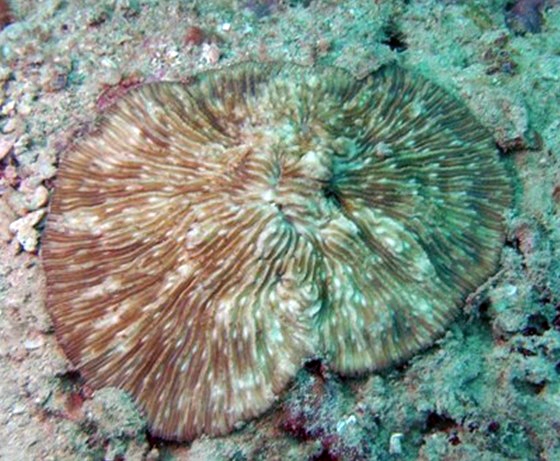| Citation |
|
Description |
Geographic Range [top]
Range Description: This species is only found in northeast Borneo (Malaysia and Indonesia) and has a restricted range.
Countries occurrence:
Native:
Indonesia; Malaysia; Philippines
FAO Marine Fishing Areas:
Native:
Pacific – western central
Additional data:
? Estimated area of occupancy (AOO) - km2: 243
? Number of Locations: 1
? Lower depth limit (metres): 20
? Upper depth limit (metres): 10
Range Map: Click here to open the map viewer and explore range.
Population [top]
Population: There is no species specific population information available for this species. However, there is evidence that overall coral reef habitat has declined.
The age of first maturity of most reef building corals is typically three to eight years (Wallace 1999) and therefore we assume that average age of mature individuals is greater than eight years. Furthermore, based on average sizes and growth rates, we assume that average generation length is 10 years, unless otherwise stated. Total longevity is not known, but likely to be more than ten years. Therefore any population decline rates for the Red List assessment are measured over at least 30 years. See the Supplementary Material for further details on generation length estimates.
[Get Adobe Reader]
For further information about this species, see Corals_SupportingDoc.pdf.
A PDF viewer such as Adobe Reader is required.
Current Population Trend: Unknown
Additional data:
? Population severely fragmented: Yes
Habitat and Ecology [top]
Habitat and Ecology: This species is found commonly below a depth of 10 m in the inner part of Darvel Bay on steep hard substratum (Ditlev 2003). This species can be found to 20 m.
Systems: Marine
Generation Length (years): 10
Threats [top]
Major Threat(s): This species is very local. Within its limited range, threats include siltation due to deforestation.
In general, the major threat to corals is global climate change, in particular, temperature extremes leading to bleaching and increased susceptibility to disease, increased severity of ENSO events and storms, and ocean acidification.
Coral disease has emerged as a serious threat to coral reefs worldwide and a major cause of reef deterioration (Weil et al. 2006). The numbers of diseases and coral species affected, as well as the distribution of diseases have all increased dramatically within the last decade (Porter et al. 2001, Green and Bruckner 2000, Sutherland et al. 2004, Weil 2004). Coral disease epizootics have resulted in significant losses of coral cover and were implicated in the dramatic decline of acroporids in the Florida Keys (Aronson and Precht 2001, Porter et al. 2001, Patterson et al. 2002). In the Indo-Pacific, disease is also on the rise with disease outbreaks recently reported from the Great Barrier Reef (Willis et al. 2004), Marshall Islands (Jacobson 2006) and the northwestern Hawaiian Islands (Aeby 2006). Increased coral disease levels on the GBR were correlated with increased ocean temperatures (Willis et al. 2007) supporting the prediction that disease levels will be increasing with higher sea surface temperatures. Escalating anthropogenic stressors combined with the threats associated with global climate change of increases in coral disease, frequency and duration of coral bleaching and ocean acidification place coral reefs in the Indo-Pacific at high risk of collapse.
Localized threats to corals include fisheries, human development (industry, settlement, tourism, and transportation), changes in native species dynamics (competitors, predators, pathogens and parasites), invasive species (competitors, predators, pathogens and parasites), dynamite fishing, chemical fishing, pollution from agriculture and industry, domestic pollution, sedimentation, and human recreation and tourism activities.
The severity of these combined threats to the global population of each individual species is not known.
Conservation Actions [top]
Conservation Actions: All corals are listed on CITES Appendix II. Parts of the species’ range fall within Marine Protected Areas.
Recommended measures for conserving this species include research in taxonomy, population, abundance and trends, ecology and habitat status, threats and resilience to threats, restoration action; identification, establishment and management of new protected areas; expansion of protected areas; recovery management; and disease, pathogen and parasite management. Artificial propagation and techniques such as cryo-preservation of gametes may become important for conserving coral biodiversity.
Citation: Hoeksema, B., Rogers, A. & Quibilan, M. 2008. Lithophyllon ranjithi. The IUCN Red List of Threatened Species 2008: e.T133517A3783173. http://dx.doi.org/10.2305/IUCN.UK.2008.RLTS.T133517A3783173.en. Downloaded on 04 June 2018.
Disclaimer: To make use of this information, please check the .
Feedback: If you see any errors or have any questions or suggestions on what is shown on this page, please provide us with feedback so that we can correct or extend the information provided
|

